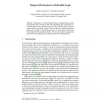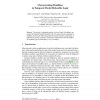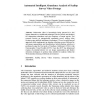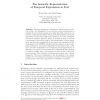AUSAI
2007
Springer
14 years 5 months ago
2007
Springer
AUSAI
2007
Springer
14 years 5 months ago
2007
Springer
In this paper, we propose a method where humanoid robot acquires meanings of grammatical connectives using direct physical feedback from human. Our system acquired 70% connectives ...
AUSAI
2007
Springer
14 years 5 months ago
2007
Springer
In this paper, we extend Defeasible Logic (a computationally-oriented non-monotonic logic) in order to deal with temporalised rules. In particular, we extend the logic to cope with...
AUSAI
2007
Springer
14 years 5 months ago
2007
Springer
Abstract. We provide a conceptual analysis of several kinds of deadlines, represented in Temporal Modal Defeasible Logic. The paper presents a typology of deadlines, based on the f...
AUSAI
2007
Springer
14 years 5 months ago
2007
Springer
Underwater video is increasingly being pursued as a low impact alternative to traditional techniques (such as trawls and dredges) for determining abundance and size frequency of ta...
AUSAI
2007
Springer
14 years 5 months ago
2007
Springer
Abstract. Temporal expressions—references to points in time or periods of time—are widespread in text, and their proper interpretation is essential for any natural language pro...
AUSAI
2007
Springer
14 years 5 months ago
2007
Springer
The traditional concept of a genetic algorithm (GA) is that of selection, crossover and mutation. However, a limited amount of data from the literature has suggested that the nich...
AUSAI
2007
Springer
14 years 5 months ago
2007
Springer
This paper details updated results concerning an implementation of a Multiple Classification Ripple Down Rules (MCRDR) system which can be used to provide quality Decision Support ...
AUSAI
2007
Springer
14 years 5 months ago
2007
Springer
AUSAI
2007
Springer
14 years 5 months ago
2007
Springer
Abstract. We present a novel algorithm called DBSC, which finds subspace clusters in numerical datasets based on the concept of ”dependency”. This algorithm employs a depth-�...




